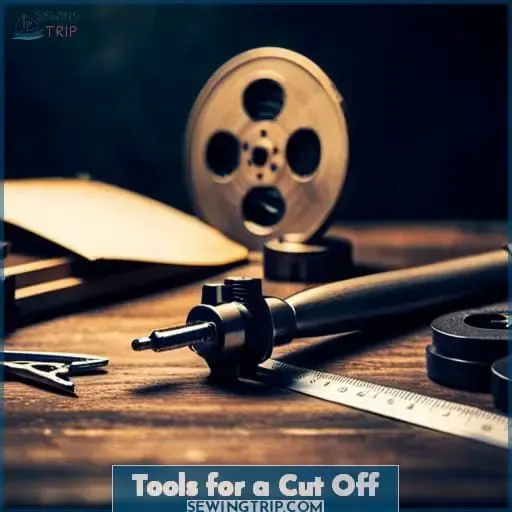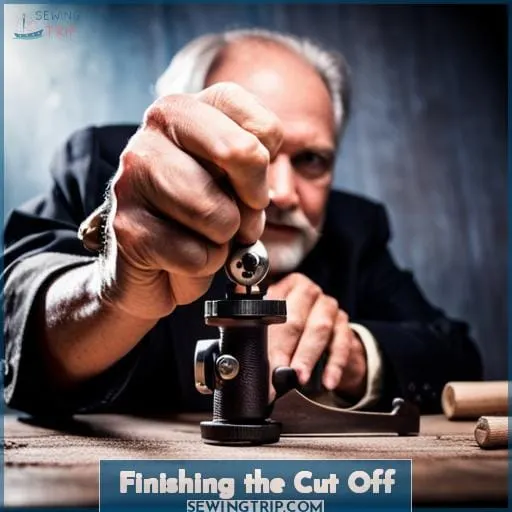This site is supported by our readers. We may earn a commission, at no cost to you, if you purchase through links.
Ahoy, fashionistas! Looking to upgrade your wardrobe with a new cut-off shirt? Well, look no further.
Learn how to masterfully craft a cutoff shirt and stand out from the crowd – all it takes is some tools, knowledge of incisions, and heat treating techniques.
So let’s dive into what makes this project so great: the benefits of owning your own custom-made piece (you won’t need expensive trips to the mall anymore), necessary tools like the Fiskars Titanium Rotary Cutter 45mm or Dritz Soapstone Marking Pencils, as well as an understanding of processes such as ambidextrous incision and heat treating cuts off shirts for maximum durability.
Get ready; we’re about to show you how it’s done!
Table Of Contents
Key Takeaways

- The Fiskars Titanium Rotary Cutter and Dritz Soapstone Marking Pencil are essential tools for making a cut-off shirt.
- Heat treating the fabric after cutting improves its quality and durability.
- Precision and clean cuts are important for a stylish and professional-looking cut-off shirt.
- Taking safety precautions, such as using sharp blades and accurate markings, is crucial when cutting fabric.
Benefits of a Cut Off
Having a well-trimmed cut-off in your wardrobe can boost your self-confidence and help show off those muscles! With improved posture, you’ll find yourself standing taller with greater confidence. A cut-off also enhances the look of muscles by providing an accurate fit that is both comfortable and stylish.
The best-case scenario would be to use a cutting tool, such as a rotary cutter, along with a solid cutting surface for added durability and protection against fabric damage. Create reference marks using special marking pencils or soapstones to ensure precise cuts are made.
These cuts will last through many washings without fraying or unraveling at the edges.
Taking these steps to prepare this garment before hand sewing it together ensures long-lasting results when it comes time to wear them out on the town! By incorporating extended durability, better posture, improved confidence, and an enhanced muscle look into one piece of clothing, you can have peace of mind knowing that no matter what occasion arises, you’ll always be prepared with an outfit ready for any situation!
Tools for a Cut Off
Gearing up to create a cutoff? Look no further than the Fiskars Titanium Rotary Cutter, 45mm, and Dritz Soapstone Marking Pencil. These tools are essential for creating precise cuts that will last through numerous washings without fraying or unraveling at the edges.
Fiskars Titanium Rotary Cutter, 45mm
Experience the power of the Fiskars Titanium Rotary Cutter, 45mm, and unleash your creative potential with its titanium coating for improved durability and sharpness. Get ahead in style with an ergonomic handle that’s built for comfort, plus a safety slider to keep you protected when not in use.
The perfect cut-off starts here:
- Start on a solid cutting surface using the cutting wheel.
- Mark where cuts should be made with top reference cut.
- Use tension while making precise lines.
- Finish off by ironing over to set it all into place!
An absolute must-have, this cutter will help you achieve clean results each time – no matter how many layers of fabric or vinyl you have.
Create your own unique look today – take advantage of the Fiskars Titanium Rotary Cutter’s advanced technology now!
Dritz Soapstone Marking Pencil
Create your perfect cut-off with the help of a Dritz Soapstone Marking Pencil! This easy-to-use tool is safe for all fabric types and won’t leave permanent marks, making it ideal for marking dark colors or woven fabrics.
Recommended by Sunbrella, this pencil works great on canvas. So, get ready to craft some unique looks today! Start with a flat surface and use heat treating to line up marks along your whole shirt. Then, take an ambidextrous incision using the Fabric pencil as you move from shoulder to scapula.
Keep tension while cutting for arm-accentuating cuts that create a sleeveless silhouette like no other! Finish up by ironing over.
Process for Creating a Cut Off
You can easily make a stylish cut-off with just two tools: the Fiskars Titanium Rotary Cutter and Dritz Soapstone Marking Pencil.
To begin your project, use the pencil to create cutting angles and design patterns on fabric that has been stretched tight. Make sure you have a precise trimming plan before starting so you get quality results after each step.
Start your first cut-off by using a sharp pair of heavy-duty scissors along the reference line. Maintain a finger grip on the fabric while cutting for better accuracy in making cuts at the right angle, as well as achieving the desired length or dimension size.
Once done creating all necessary cuts, then check its quality by stretching it once again to confirm that there are no extra threads sticking out from the edges, which can cause fraying later when washed or worn multiple times.
With these tips in mind, you’ll be ready for your next fashion statement piece!
Steps for Creating a Cut Off
Put your crafting skills to the test and show off those muscles with a stylish cut-off! To get started, sharpen up techniques with an ambidextrous cut on any fabric selection.
Before beginning, follow safety guidelines: wear protective gear and always keep tension applied while cutting. Start by making a first cut down from the shoulders along the reference line using heavy-duty scissors or a fixed blade knife – whichever works best for you.
Be sure to center logos before finalizing cuts so that they are not distorted in any way afterwards.
Finally, transfer the completed project onto a sturdy board or table to ensure smoothness of edges. Finish up with the dryer setting at high heat temperature for a 20-minute long cycle time.
Ambidextrous Incision
To perfect your ambidextrous incision, remember that it takes an average of 10 minutes per sleeve.
To ensure a successful cut off, use an ergonomic handle with a safety guard and put fabric tension on the cutting edges to avoid shoddy cuts.
Additionally, make sure you have a solid cutting surface to protect the material before beginning.
As for the final step in creating a cut-off, when finished marking out all lines with your middle finger touching the shoulder blade area firmly, use your own fingers as support and start making those clean cuts!
From there, you can move onto designing your desired look and take pride in owning something unique that is created just for you!
Heat Treating the Cut Off
Now that your cuts are complete, it’s time to heat treat the cut-off for optimal effects. Heat treating helps improve fabric quality and durability factors by sealing off potential jagged edges at the end of each cut.
With this cutting technology, you can achieve precise slashes while also maintaining a safe environment with safety measures in place. Not only will heat treating give your vintage t-shirt collection a unique boost of self-confidence, but it will also provide an extra layer of protection from fraying or wear and tear over time due to washing or other activities.
So don’t wait any longer! Get ready to experience freedom like never before as you show off those muscles with confidence!
Materials and Tools
You’ll need the right materials and tools to heat treat your cut-off for a perfect finish – think Fiskars Titanium Rotary Cutter, Dritz Soapstone Marking Pencil, and of course an iron!
Whether you’re creating stencils or cutting fabric for workout shirts or tank tops, having the correct equipment is key. A bigger pair of sharper scissors will make it easier to mark guidelines before cutting; make sure that they are ambidextrous if you want great results with minimal effort.
Finally, when it comes time to start heat treating your shirt cuts – make use of those generic kindergarten safety scissors! This way, you can avoid any unexpected accidents while still achieving maximum precision in styling up that type of shirt.
With all these tools at hand and a little bit of creativity on top – there’s no limit to what kind of unique fashion statement you can create with one simple cut-off t-shirt!
Making Lineup Marks
Mark the fabric with a Dritz Soapstone Marking Pencil to get your cut-off looking sharp and professional. To ensure precision measurements, make sure you keep tension on the fabric as you’re cutting at a 45-degree angle.
Create clear layouts for parallel lines by using your second knuckle as a good rule of thumb. This will help guarantee an even end product! Cut from the outside halves of the torso all along to just above or below where it meets with the bottom of the shirt.
For optimal results, take extra time when making lineup marks and measuring cuts beforehand.
Finishing the Cut Off
Finally, trim off any excess fabric for a sleek and stylish finish to your cut-off. To perfect the fit, use cutting methods such as scissors or an electric rotary cutter on the right line you’ve previously marked.
Sealing edges is essential – iron over them with interfacing material before hemming or sewing down sleeves and bottom hems of the shirt. If you’re a first-timer at making cutoffs, don’t worry! Take your time adjusting length and securing sleeves until it fits perfectly around your body.
Cutting Methods
Perfecting Fit
Sealing Edges
Securing Sleeves
Adjusting Length
Well-trimmed Cut Off
Now that everything is set in place, all that’s left to do is slip into something comfortable – the newly created cutoff shirt! Rejoice in knowing now you can show off those muscles while feeling empowered by crafting liberation through fashion mastery with confidence every single day!
Frequently Asked Questions (FAQs)
How long does it take to make a cut off?
Creating a cutoff doesn’t take long – just fold, mark, and snip. It’s the perfect way to show off those muscles and build your confidence.
Is it easy to make a cut off?
Creating a cutoff isn’t difficult if you have the right tools and know-how. The secret lies in outlining, folding, centering – then cutting with tension for precision.
What is the best way to cut a cut off?
The best way to cut a cutoff is with precision and creativity. Use a craft rotary cutter for clean, perfect cuts every time. Mark the fabric beforehand with an easy-to-use soapstone pencil and fold arms at 90° angles for accuracy.
Are there any safety tips when making a cut off?
Are you cutting with a sharp blade? Make sure to always use the sliding button on your rotary cutter for safety and keep tension on the fabric while cutting.
How do I store my cut off after it is made?
Store your cut-off in a cool, dry place. Hang or fold it to avoid stretching the fabric and causing damage. For additional protection, use an acid-free garment bag to preserve its quality over time.
Conclusion
Having a cutoff in your wardrobe can be a great way to show off your muscles and boost your confidence. With the right tools and a bit of practice, you can create a cutoff that looks professional and fits perfectly.
And with an ambidextrous cut, you can show off your style with either arm. Heat-treating your cutoff will ensure it rolls inward for a neat finish. Like a butterfly emerging from a chrysalis, you can create a unique cutoff that expresses your individual style.















